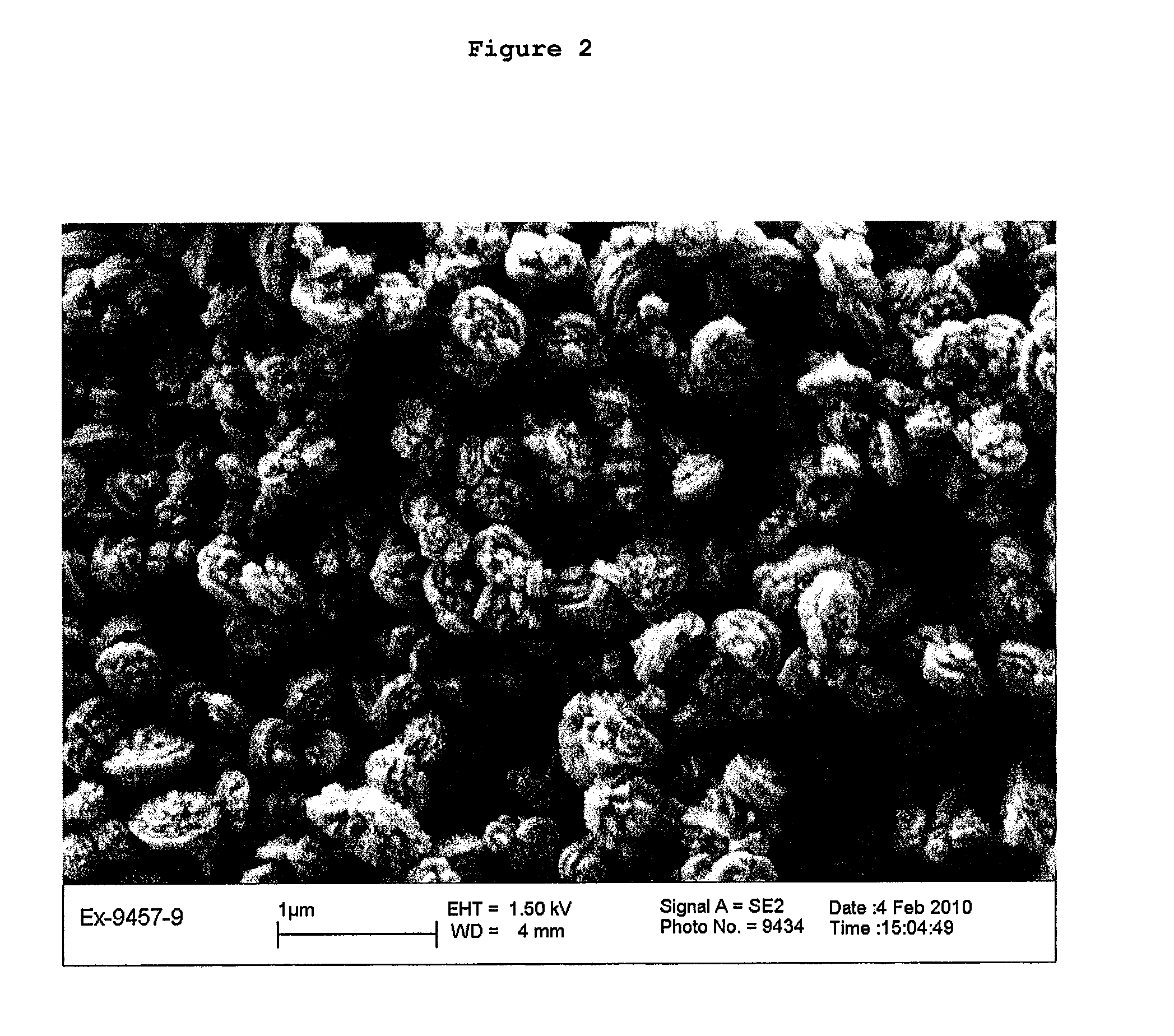Hydrothermal synthesis of zeolites or zeolite-like materials using modified mixed hydroxides
a technology of zeolites and zeolites, which is applied in the direction of silicon compounds, cellulosic plastic layered products, physical/chemical process catalysts, etc., can solve the problems of less expensive sodium silicate solutions, and more expensive sources, such as precipitated silicas or colloidal silica sols, must therefore be used
- Summary
- Abstract
- Description
- Claims
- Application Information
AI Technical Summary
Benefits of technology
Problems solved by technology
Method used
Image
Examples
example a
Production of the Mixed Hydroxide
[0121]45.1 kg of a sodium water glass solution (10.4 wt.-% NaOH and 26.6 wt.-% SiO2, PQ Corp.; solution 1) is placed in a receiver vessel, and 31.1 kg of an aluminium sulphate solution (8.1 wt.-% Al2O3, Giulini BK; solution 2) is placed in a further receiver vessel. In a 120-dm3 agitator vessel, a solution of 5.02 kg potassium hydroxide (86 wt.-%, MERCK) in 38.9 kg demineralized water is prepared (solution 3). At ambient pressure (approximately 1 bar) and a temperature of 25° C., solutions 1 and 2 are introduced simultaneously into the agitator vessel with solution 3 accompanied by stirring at a volumetric flow rate of from 150 to 500 cm3 / min. The mixed hydroxide precipitates in the form of a precipitate. The pH is recorded to monitor the precipitation progress. At the end of the precipitation, a pH in the range of from 7.5 to 9 is achieved. The batch is then aged accompanied by stirring at 25° C. and at ambient pressure (approximately 1 bar) for thr...
example 1
Production of a Synthesis Gel and an Aluminium Silicate of the Type LTL (Zeolite L)
[0123]The obtained precursor is then used for the following production of a synthesis gel:
[0124]In a pressure vessel, 1.56 kg potassium hydroxide (86 wt.-%, MERCK) and 2.26 kg potassium carbonate (99 wt.-%, PROLABO) are dissolved in 19 kg demineralized water. To this, 7.87 kg of the above-described mixed hydroxide A (precursor) is added. The obtained synthesis gel has the following molar composition:
[1.000SiO2:0.125Al2O3:0.094K2O:0.038Na2O]:0.150K2O:0.200K2CO3:15.000H2O
and is stirred for eight hours at 25° C. and under ambient pressure. Then the vessel is closed and heated to 130° C. within two hours accompanied by stirring. The stirrer is then switched off and the batch is kept at 130° C. for a further 30 h.
[0125]After cooling, the stirrer is switched on to produce a suspension and the pressure vessel is completely emptied. The obtained solid is filtered off, washed and dried at 120° C. for approxima...
production examples 2 and 3
[0129]A synthesis gel is produced using the mixed hydroxide B (see Table 1) with an SiO2 / Al2O3 ratio (SAR) of approximately 10.
[0130]The basic solution 4 is produced by mixing two potassium sources, potassium hydroxide and potassium carbonate, wherein a molar composition of the finished gel of 0.15K12O / SiO2 and 0.20K2CO3 / SiO2 is obtained (see Table 2, synthesis gel n). The total potassium content in the mixed hydroxide gel Ktotal2O / SiO2 is 0.41.
[0131]The synthesis takes place over a period of 24 hours at 170° C. (Example 2, Table 3). The material collected after working up once the synthesis has ended is pure zeolite L according to the X-ray diffraction diagram. The Si / Al ratio in the end product of Example 2 is 3.1 (see Table 4).
[0132]Using the same molar gel composition, the synthesis was carried out at lower temperatures, 130° C. (Example 3, Table 3), with a synthesis duration of 48 hours. A pure material of the type zeolite L was identified by X-ray diffraction analysis, which s...
PUM
| Property | Measurement | Unit |
|---|---|---|
| particle size D50 | aaaaa | aaaaa |
| specific surface area | aaaaa | aaaaa |
| diameter/height | aaaaa | aaaaa |
Abstract
Description
Claims
Application Information
 Login to View More
Login to View More - R&D
- Intellectual Property
- Life Sciences
- Materials
- Tech Scout
- Unparalleled Data Quality
- Higher Quality Content
- 60% Fewer Hallucinations
Browse by: Latest US Patents, China's latest patents, Technical Efficacy Thesaurus, Application Domain, Technology Topic, Popular Technical Reports.
© 2025 PatSnap. All rights reserved.Legal|Privacy policy|Modern Slavery Act Transparency Statement|Sitemap|About US| Contact US: help@patsnap.com



